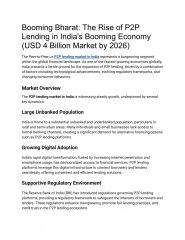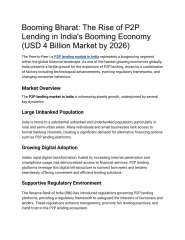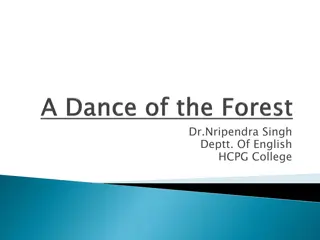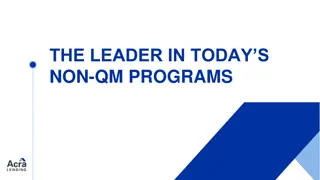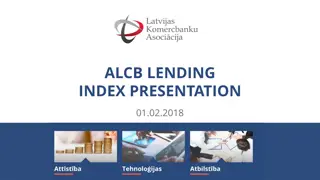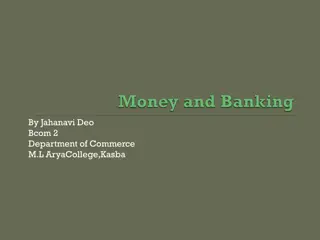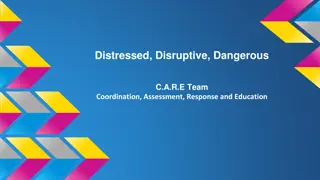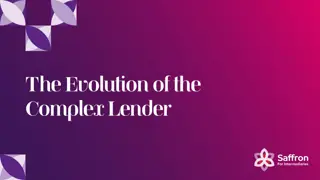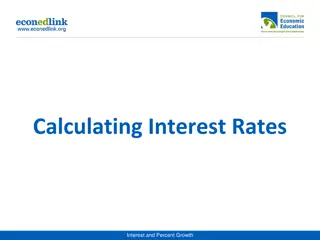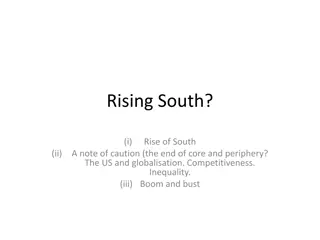Distressed Lending and Strategic Investment: A Cautionary Tale
Explore the challenges faced by secured lenders, strategic investors, and gift plans in the realm of distressed lending and strategic investment. The article delves into topics such as credit bidding rights, disallowed votes, and the viability of secured lender cram downs, offering insights and potential alternatives for stakeholders navigating complex financial landscapes.
Uploaded on Sep 22, 2024 | 2 Views
Download Presentation

Please find below an Image/Link to download the presentation.
The content on the website is provided AS IS for your information and personal use only. It may not be sold, licensed, or shared on other websites without obtaining consent from the author.If you encounter any issues during the download, it is possible that the publisher has removed the file from their server.
You are allowed to download the files provided on this website for personal or commercial use, subject to the condition that they are used lawfully. All files are the property of their respective owners.
The content on the website is provided AS IS for your information and personal use only. It may not be sold, licensed, or shared on other websites without obtaining consent from the author.
E N D
Presentation Transcript
Distressed Lending and Strategic Investment: A Cautionary Tale Presented by: Ancela R. Nastasi Richards Kibbe & Orbe LLP One World Financial Center New York, New York 10281 anastasi@rkollp.com (212) 530-1837 David W. Prager, CFA Goldin Associates, LLC 350 Fifth Avenue New York, New York 10118 dprager@goldinassociates.com (212) 593-2255 Date: September 20, 2011
Introduction I. Secured Lenders: Will Your Right to Credit Bid Be Honored In a Cram Down Plan? II. Strategic Investors: Could Your Votes Be Disallowed? III. Gift Plans: Are They Still Viable? IV. Secured Lender Cram Downs: A Viable Alternative for Debtors and Junior Lenders? 1
I. Secured Lenders: Will Your Right to Credit Bid Be Honored In a Cram Down Plan? At the sale of its collateral, credit bidding enables a secured lender to pay the purchase price via forgiveness of the notional amount of the debt. State law allows secured creditors to credit bid their debt at foreclosure sales. Bankruptcy Code section 363(k) provides that unless the court, for cause, orders otherwise, a secured creditor can credit bid its allowed claim at a sale of its collateral. In addition to selling assets under Bankruptcy Code section 363, debtors can sell assets under a plan. The Bankruptcy Code s cram down provisions specifically reference the right of a secured lender to credit bid under section 363(k). 2
I. Secured Lenders: Will Your Right to Credit Bid Be Honored In a Cram Down Plan? (cont d) Credit bids are the safety net for a secured lender in an environment that might otherwise not be conducive to robust bidding: Short timeline Limited investor base Potential management self-interests However, junior stakeholders often contend that credit bidding discourages cash bidders and chills a competitive auction. Junior stakeholders are most concerned when: The initial credit bid is well below the intrinsic value of the collateral and/or the notional value of the senior debt; Intrinsic value of the collateral only slightly exceeds the notional value of the senior debt; Few strategic buyers are available; and/or Debt is held by a non-traditional lender and/or was acquired at a discount. 3
I. Secured Lenders: Will Your Right to Credit Bid Be Honored In a Cram Down Plan? (cont d) Pacific Lumber Co., 584 F.3d 229 (5th Cir. 2009) secured creditors not permitted to credit bid for assets following judicial sale Philadelphia Newspapers, 599 F.3d 298 (3d Cir. 2010) secured creditors not permitted to credit bid for assets at public auction River Road, 2011 WL 2547615 (7th Cir. 2011) secured creditors are permitted to credit bid in an asset sale pursuant to a cram down plan A petition for writ of certiorari has been filed and is expected to be decided in the late Fall of 2011 4
I. Secured Lenders: Will Your Right to Credit Bid Be Honored In a Cram Down Plan? (cont d) The economics of a credit bid can be largely replicated if the sales proceeds flow directly to the secured lender. If distributions follow shortly after the sale closes, a cash bid may largely replicate a credit bid (assuming bidder has easy, inexpensive access to short term capital). Costs of the sale, as well as funding for wind down operations, often are netted from a cash transaction before distribution. This structure may become more difficult where potential challenges to senior debt exist. However, cash bidding by can be difficult for some investors due to liquidity, regulatory and other constraints. 5
I. Secured Lenders: Will Your Right to Credit Bid Be Honored In a Cram Down Plan? (cont d) Credit bidding has the potential to create incremental value for junior stakeholders. Assets Intrinsic Value 900 Sr. Debt Purchase Price Face Value 800 1,000 Third Party Bid Credit Bid Cost Bid Cost Bid Consideration Sr Debt (Credit Bid) Cash Total 800 100 900 1,000 1,100 900 900 900 900 100 Recovery Sr. Debt Jr. Stakeholders Total 900 - - 1,000 1,100 100 6
I. Secured Lenders: Will Your Right to Credit Bid Be Honored in an Asset Sale Under a Cram Down Plan? (cont d) Assuming, arguendo, that credit bidding has the potential to quell competitive bidding, who is harmed? If the market price of assets is less than senior debt level, the senior debtholders (aka, credit bidder) accrue all benefits and suffer all losses from influences on bidding process no harm to junior stakeholders. If the market price of assets exceeds senior debt, the credit bidder will have to pay a portion of price in incremental cash; if the cash payment is substantial, the credit bidder will have little perceived advantage and, therefore, alternative bidders will not be discouraged no harm to junior stakeholders. Incremental Value to Jr. Stakeholders Little Perceived Advantage of Credit Bid Sr. Debt Level Incremental Value to Sr. Debtholders Large Perceived Advantage of Credit Bid 7
I. Secured Lenders: Will Your Right to Credit Bid Be Honored Sale In a Cram Down Plan? (cont d) Bottom Line: Secured lenders doing business with borrowers in the Third Circuit (i.e., Delaware, New Jersey or Pennsylvania) or the Fifth Circuit (i.e., Louisiana, Mississippi or Texas) should beware that in a cram down plan, the right to credit bid will not be honored. In other jurisdictions outside of the Third Circuit, the Fifth Circuit and Seventh Circuit (i.e., Illinois, Indiana, Wisconsin), such right may not be honored. Pending Supreme Court review of the River Road decision, in all jurisdictions outside of the Seventh Circuit, consider the following courses of action: If the debtor needs the consent of the lender to use cash collateral or needs post-petition financing and the lender itself wishes to provide it, consider conditioning that consent on obtaining an order giving the lender the right to credit bid in the event of a sale of the collateral. In a sale of the debtor s assets pursuant to a plan, if the right to credit bid is not honored, consider submitting a cash bid for the collateral, conditioned on the debtor paying the secured claim in cash in full (i.e., with the sale proceeds) no later than a date certain. 8
II. Strategic Investors: Could Your Votes Be Disallowed? In order to confirm a plan under section 1129(a) of the Bankruptcy Code (and avoid cram down under section 1129(b)), among other requirements, acceptance of the plan must be obtained from each impaired class. A class of impaired creditors is deemed to have accepted the plan if the holders of least two-thirds in amount and more than half in number vote in favor. Bankruptcy Code section 1126(e) allows the court to designate the votes of an entity whose acceptance or rejection of such plan was not in good faith. The votes of any entity so designated are not counted in determining acceptance or rejection of the plan. 9
II. Strategic Investors: Could Your Votes Be Disallowed? (cont d) DBSD v. DISH, 634 F.3d 79 (2d Cir. 2011) Facts: Debtor filed a plan which proposed repaying the first lien debt with a take back note. Competitor DISH purchased all of the first lien debt at par after the plan was filed; DISH also bought second lien debt, but only that amount not subject to a plan support agreement. DISH s internal documents showed that it bought the debt to gain control of debtor. Ruling: Section 1126(e) comes into play when voters venture beyond mere self-interested promotion of their claims. The court designated DISH s votes as having been cast in bad faith. 10
II. Strategic Investors: Could Your Votes Be Disallowed? (cont d) The Bottom Line: Acquire claims before the plan is filed. Pay fair market value (or less) for claims. Consider making a more traditional bid for the assets. Disclose actions and/or strategy, where practical. If you are a competitor of debtor, proceed with caution. Educate the court about specifics of relationship with debtor (i.e., synergies) 11
III. Gift Plans: Are They Still Viable? The absolute priority rule mandates that a chapter 11 plan cannot be confirmed over the objection of an impaired class unless: The dissenting class receives the full value of its claim, or Junior creditors and/or interest holders receive no property on account of their claim(s) or interest(s). Notwithstanding the absolute priority rule, compromises have often been proposed in which senior creditors bypass intermediate classes and give-up or gift a portion of their recoveries to junior classes in order to obtain consensus. 12
III. Gift Plans: Are They Still Viable? Armstrong World Industries, 432 F.3d 507 (3d. Cir. 2005) Gifting to shareholders in a chapter 11 plan where other impaired debtholders objected constituted a violation of the absolute priority rule. [A] plan cannot give property to junior claimants over the objection of a more senior class that is impaired. World Health Alternatives, 344 B.R. 291 (Bankr. Del. 2006) Secured creditor made a gift to unsecured creditors which bypassed priority creditor classes. The gift was made as part of the settlement of a lien dispute. Court approved settlement. Iridium, 478 F.3d 452 (2d Cir. 2007) Court declined to decide whether gifting could occur in a settlement outside a chapter 11 plan, but did note that if the settlement was fair and equitable and if traditional settlement factors weighed in favor of the settlement, then such settlement could be approved. 13
III. Gift Plans: Are They Still Viable? (cont d) DBSD v. DISH , 634 F.3d 79 (2d Cir. 2011) Facts: The gift-givers (second lien lenders) were undersecured. Unsecured creditors received a gift, but even with it, they were not being paid in full. Equity also received a gift and stood to receive more than unsecured creditors. Gift recipients did not receive their gifts from the gift giver, but instead got them from the debtor under the plan. Ruling: The gift plan violated the absolute priority rule and was unconfirmable. 14
III. Gift Plans: Are They Still Viable? (cont d) The Bottom Line If DBSD holds, gift plans will be difficult in the Second Circuit. DBSD does not address intercreditor (or stakeholder) agreements outside of plan. Disclose to court (and potentially in disclosure statement). Structures could be developed to economically replicate gift plans, though these structures are not without risk. Gift recipient might cede certain rights (e.g., avoidance or derivative actions) in exchange for gift, effectively cashing out an illiquid asset. Non-cash plan currency may leave ambiguity as to the satisfaction of the absolute priority rule. Don t be greedy recipient class should not receive more than the value of avoiding time and expense of litigation. 15
IV. Secured Lender Cram Downs: A Viable Alternative for Debtors and Junior Lenders? Cram down is a mechanism for obtaining confirmation of a plan over the objection of one or more classes of dissenting creditors. In a cram down, the plan proponent re-writes the prepetition contract. In order to be crammed-down, secured lenders must receive one of the following treatments: Lien Retention and Cash. Retention of their liens to the extent of the allowed amount of their claims, and deferred cash payments of a value, as of the effective date of the plan, equal to the value of their interest in the collateral; Sale. Subject to the right to credit bid under section 363(k), sale of the collateral securing their liens free and clear of such liens, with liens to attach to the proceeds of sale; or Indubitable Equivalent. The receipt of the indubitable equivalent of their claims. 16
IV. Secured Lender Cram Downs: A Viable Alternative for Debtors and Junior Lenders? (cont d) Till v SCS Credit Corp., 541 US 465 (2004) Chapter 13 case. Interest rate on new debt set by a formula of prime plus 1% to 3%, depending on the risk of default associated with the debtor. In a footnote, court noted that the prime plus formula may not be appropriate in a chapter 11 case where the market for DIP financing could provide an interest rate. American Home Patient, 420 F.3d 559 (6th Cir. 2005) Sixth Circuit applied Till to a chapter 11 case, and adopted its two- pronged test. First, determine whether the preponderance of evidence shows an efficient market interest rate for the loan and whether the plan reflects such rate. Second, if the market rate cannot be determined, proceed with the prime plus formula. 17
IV. Secured Lender Cram Downs: A Viable Alternative for Debtors and Junior Lenders? (cont d) DBSD, 634 F.3d 79 (2d Cir. 2011) Plan provided for secured creditor to be crammed down with a highly speculative new note on far less favorable terms than existed prepetition. The new note (a) PIK d interest at the pre-default, pre-forbearance rate of 12.5% per annum, (b) matured in four years, with a balloon payment due at maturity, (c) eliminated or modified certain covenants, and (d) contained less restrictive cross-default provisions. Court confirmed the plan. Mace, 2011 WL 284435 (Bankr. M.D. Tenn. 2011) Secured lender crammed down with note at 6% interest going to prime plus 2% after five years (with a 6% floor and 11% cap), and a term of 20 years (as opposed to typical 5 to 7 year term). Red Mountain, 2011 WL 1428266 (Bankr. D. Az. 2011) The debtor had proposed a cram down interest rate of 6%; the secured lender argued that 8.5% to 10.5% was appropriate. Court crammed down secured lender with a 6.5% interest rate and 15 year repayment term. 18
IV. Secured Lender Cram Downs: A Viable Alternative for Debtors and Junior Lenders? (cont d) Oversecured creditors are entitled to face value of claim. Undersecured creditors are entitled to value of collateral (or ratable share of company if unsecured or election is made to be treated as such). Where new loans are to be crammed down, defining indubitable equivalent can be difficult. Till may leave open potential to use market rate, where available. Cramdown and Treasury Interest Rates 16% Cram Down Rate 14% Treasury Rate 12% 10% Till 8% 6% 4% 2% 0% 19
IV. Secured Lender Cram Downs: A Viable Alternative for Debtors and Junior Lenders? (cont d) Loan characteristics should be incorporated in interest rate. Courts need guidance on the economic impact of: Covenants: Protections for lenders (such as coverage ratios, change in control, etc.) result in lower rates; the impact of these covenants may depend on market conditions. Leverage: Higher senior and total loan-to-value ratios drive higher interest rates. Business Plan and Capital Structure: Viability of business and its ability to withstand shocks should be reflected in rate; reorganized business is not always safer than the business to which loan was originally advanced. While Till seems to indicate a variance of only 2% in appropriate cram down interest rates, market dictated rates on exit financing (and cram down loans by extension) can vary by 10%+. Repayment must be reasonably expected in order for plan to be feasible. 20
IV. Secured Lender Cram Downs: A Viable Alternative for Debtors and Junior Lenders? (cont d) The Bottom Line: Terms of cram down note do not have to mirror terms of pre-petition note, and can be far worse. Consider potential for cram down in pre-bankruptcy negotiations. Consider bargaining for anti-cram down provisions in a cash collateral order or debtor-in-possession financing order. Ability to cram down will depend on expert testimony regarding valuation, market interest rates and financial feasibility. 21
Distressed Lending and Strategic Investment: A Cautionary Tale Ancela R. Nastasi Richards Kibbe & Orbe LLP One World Financial Center New York, New York 10281 anastasi@rkollp.com (212) 530-1837 David W. Prager, CFA Goldin Associates, LLC 350 Fifth Avenue New York, New York 10118 dprager@goldinassociates.com (212) 593-2255 22
Ancela R. Nastasi Richards Kibbe & Orbe LLP T: 212.530.1837 | F: 917.344.8837 anastasi@rkollp.com Ancela R. Nastasi is a partner in the Restructuring and Bankruptcy Group. She has extensive experience representing the full range of participants in complex chapter 11 cases and out-of-court restructurings, including debtors, chapter 11 trustees, secured and unsecured creditors, investors focused on distressed situations and other strategic parties. Ms. Nastasi has experience with bankruptcy-related litigation and insolvency-sensitive transactions in a broad range of industries, including financial services, telecommunications, manufacturers, restaurants and real estate concerns. Ms. Nastasi specializes in assisting her clients in devising creative and effective solutions to complex transactions and matters. Ms. Nastasi received her Bachelor of Science in Mathematics magna cum laude from Vanderbilt University and was awarded phi beta kappa. Ms. Nastasi received a Diploma in Accounting and Finance with Merit from the London School of Economics. She earned her Juris Doctor from the University of Pennsylvania School of Law where she was an editor of the Journal of International Business Law. After graduating from law school, Ms. Nastasi clerked for the Honorable Robert E. Ginsberg, Bankruptcy Judge for the Northern District of Illinois. She was formerly associated with Weil Gotshal & Manges and with Kirkland & Ellis, and was Special Counsel to Golenbock Eiseman Assor Bell & Peskoe. Ms. Nastasi is a member of the American Bankruptcy Institute, INSOL International, the International Women's Insolvency & Restructuring Confederation and the Turnaround Management Association. She serves on the Board of the Law Alumni Society of the University of Pennsylvania School of Law. Ms. Nastasi is admitted to practice before the state court of New York and the federal courts of the Southern and Eastern Districts of New York.
About Richards Kibbe & Orbe LLP Richards Kibbe & Orbe LLP is a dynamic and entrepreneurial firm with deep experience and relationships in the financial markets and business community. With approximately 100 lawyers in New York, Washington, D.C. and London, the firm provides innovative legal solutions to a sophisticated range of clients across the investment and business spectrum, from hedge funds and investment banks to corporate boards and businesses enterprises. RK&O understands its clients' business imperatives - whether in a transaction, litigation or regulatory matter - and believes that those imperatives must serve as a foundation for thoughtful and practical legal counsel. The hallmark of RK&O s lawyers is exceptional judgment, the ability to provide clients with creative solutions to the most difficult problems and a commitment to the highest caliber service in a cost-effective manner.
David W. Prager Goldin Associates, LLC T: 212.593.2255 dprager@goldinassociates.com David W. Prager, a managing director of Goldin Associates, is an experienced financial and restructuring professional who has advised debtors and creditors in both in and out-of-court restructurings and provided interim management, expert testimony and litigation support in major matters. David s clients have spanned a wealth of industries, with particular concentrations in energy, insurance and telecommunications. He was recently named among People to Watch in the Restructuring Industry by Turnaround & Workouts, a professional publication dedicated to the industry. David recently served as interim chief financial officer and restructuring advisor to Syncora Guarantee, a monoline financial guarantor. In that role, he helped lead the first comprehensive restructuring of a major monoline insurer. The effort was named one of the most successful restructurings of 2009 by Turnarounds & Workouts. Previously, David co-headed Goldin s engagement as financial advisor to creditors of FGIC, another large monoline insurer. David recently provided testimony on the fairness of Tribune Company s plan of reorganization. He was a key member of Goldin s Adelphia Communications advisory team, where he was responsible for modeling recoveries under the proposed plan and was one of the principal witnesses at the contested confirmation hearing. During the Enron bankruptcy, David investigated and valued highly complex and varied assets and formulated proposals for Enron s reorganization. David s advisory engagements have included SemGroup LP (financial advisor to creditors committee), MxEnergy (advisor to bank group), NorthWestern Corp. (advisor to subordinated creditors) and Loral Space (financial advisor to Examiner). David was formerly employed at McManus & Miles, an investment bank specializing in the power generation industry. Before that, he was a financial analyst for Guardsmark, one of the largest firms in the corporate security industry. David is a Chartered Financial Analyst ( CFA ) charterholder and is a Certified Insolvency & Restructuring Advisor ( CIRA ). He is a member of the New York Society of Securities Analysts, the CFA Institute and the Association of Insolvency and Restructuring Advisors. David has a B.S. from the Wharton School at the University of Pennsylvania.
About Goldin Associates, LLC Goldin Associates is a financial advisory and turnaround consulting firm that specializes in underperforming businesses and distressed situations, including financial and operational restructurings, crisis management and bankruptcies. Transactional and restructuring advisory Operational and turnaround consulting Forensic financial, valuation, and solvency analysis Trustee, examiner, independent fiduciary The Goldin team includes professionals with backgrounds and expertise in business valuation, financial forensic investigations, accounting, investment banking, corporate finance, financial control, operating company management, commercial and asset-backed lending and investment management. Turnarounds and Workouts, a professional publication in the restructuring industry, has designated Goldin a top restructuring advisor each year for the past twelve years. Similarly, The Deal, another industry publication, has consistently designated Goldin one of the industry's leading advisory firms. The firm has extensive experience representing stakeholders in large and complex bankruptcy cases, covering: Negotiation of restructurings in- and out-of-court, including the resolution of intercreditor disputes Evaluation of complex bankruptcy issues, including avoidance actions and equitable remedies Investigation of alleged fraud and other wrongdoing Accounting for complex claims, including mark-to-market and projected loss calculations For further information on Goldin, visit the firm s website at www.goldinassociates.com.
The information contained in this presentation is provided for informational purposes only and should not be construed as legal advice on any subject matter. This presentation is not intended to create an attorney-client relationship between you and RK&O, and no recipients of content from this presentation, clients or otherwise, should act or refrain from acting on the basis of any content included in the presentation without seeking the appropriate legal or other professional advice on the particular facts and circumstances at issue from an attorney licensed in the recipient's state. The content of this presentation contains general information, and may not reflect current legal developments, verdicts or settlements in your jurisdiction or that are relevant to any specific set of facts. RK&O expressly disclaims all liability in respect to actions taken or not taken based on any or all of the contents of this website. 663852 27


